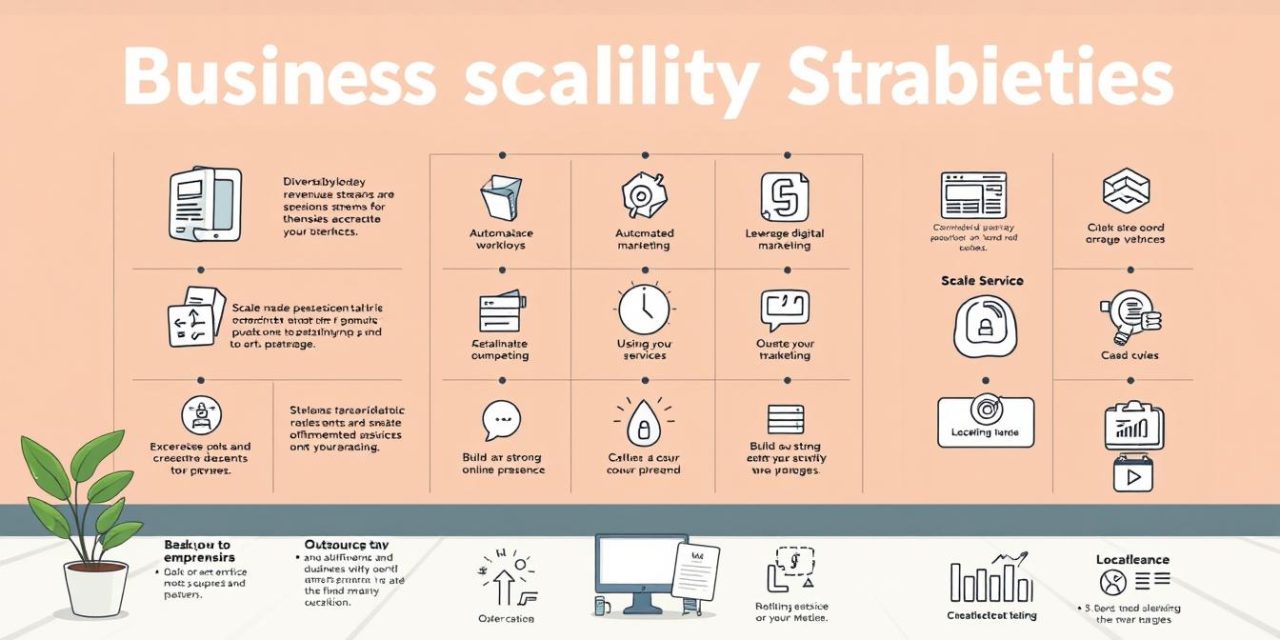What if growing your venture actually makes it harder to succeed? Many ambitious professionals face this paradox: expanding operations often leads to burnout, inefficiency, or financial strain. But what separates thriving enterprises from those that collapse under their own growth?
True success lies not in chasing every opportunity but in building systems that multiply results. Consider this: adding a $20,000 client should boost profits, not create $22,000 in new costs. This distinction separates temporary growth from sustainable scaling.
Modern tools make this achievable. Automation platforms and cloud-based workflows allow solo entrepreneurs to rival traditional companies in efficiency. We’ve seen consultants triple their capacity without hiring staff, and creators monetize digital products while sleeping.
This guide reveals how to:
- Identify bottlenecks draining your resources
- Implement tech solutions that handle repetitive tasks
- Design income streams that grow without constant effort
You’ll learn from real-world case studies, including a French freelance designer who systematized client onboarding to serve 300% more clients. These strategies work across industries—whether you’re managing e-commerce or professional services.
Table of Contents
Key Takeaways
- Scaling differs from growth: Focus on profit margins, not just revenue
- Technology enables automation, reducing manual work by up to 70%
- Standardized processes prevent quality drops during expansion
- Digital tools let small teams compete with larger companies
- Long-term planning beats short-term hustle for lasting success
Understanding Business Scalability
Expanding your operations shouldn’t feel like building a house on shifting sand. True expansion means creating structures that hold firm under pressure while delivering consistent results. Let’s explore what separates temporary surges from lasting progress.
Defining Scalability in a Business Context
A well-designed model thrives under increased demands. Imagine handling triple the orders without hiring extra staff or working weekends. This requires systems that multiply output without multiplying effort.
Consider this comparison:
| Aspect | Growth Approach | Scaling Approach |
|---|---|---|
| Profit Margins | Decrease with volume | Improve with volume |
| Resource Usage | Linear increase | Exponential efficiency |
| Long-Term Impact | Burnout risks | Sustainable workflows |
Why Sustainable Progress Matters
Chasing rapid expansion often leads to broken processes and exhausted teams. A 2023 study found enterprises focusing on adaptable systems recovered 40% faster from market shifts than competitors.
Key advantages of strategic scaling:
- Maintain service quality during demand spikes
- Adapt pricing models without operational chaos
- Automate repetitive tasks using verified digital platforms
Building these foundations early prevents costly overhauls later. It’s like installing elevator shafts during initial construction rather than retrofitting them into finished buildings.
Foundations of a Scalable Business Model
Creating systems that expand effortlessly isn’t magic—it’s strategic engineering. The difference between ventures that flourish and those that flounder often lies in their structural DNA. Let’s examine what makes certain frameworks thrive under pressure while others crumble.
Identifying Key Components of Scalability
Effective models share three pillars:
- Low marginal costs: Adding customers shouldn’t require proportional resources
- Automation-first workflows: Software handles repetitive tasks 24/7
- Network effects: Each new user increases the platform’s value
Selecting the Right Business Model
Compare these proven frameworks:
| Type | Strengths | Best For |
|---|---|---|
| SaaS | Recurring revenue | Tech solutions |
| Marketplaces | Zero inventory | Connecting industries |
| Subscriptions | Predictable income | Content/services |
Software companies exemplify this approach. Once developed, applications serve millions without rebuilds. Marketplaces like Etsy thrive by facilitating transactions rather than stocking products.
Your choice depends on three factors:
- Upfront development capacity
- Target audience behavior
- Long-term margin potential
Integrating Technology and Automation to Enhance Efficiency
Smart tools now handle tasks that once consumed entire workdays. The right technology stack transforms operations from time-intensive to self-sustaining, letting you focus on strategic decisions rather than administrative chores.
No-Code Platforms: Your Automation Launchpad
Visual builders like Zapier and Airtable let anyone create complex workflows. A bakery owner could automate ingredient orders when stock dips below 20%, or a consultant might trigger follow-up emails after client meetings – all without coding.
| Tool | Best For | Time Saved Weekly |
|---|---|---|
| Make.com | Multi-app integrations | 6-8 hours |
| Chatfuel | 24/7 customer queries | 4-5 hours |
| Canva Teams | Branded content creation | 3-4 hours |
Building Synergistic Systems
Combine tools for compounding results. HubSpot CRM paired with Calendly automates appointment scheduling and client tracking. QuickBooks syncs with Stripe to reconcile payments instantly.
AI-driven solutions take this further:
- Grammarly Business ensures consistent communication
- SurferSEO optimizes content in real-time
- Predictive analytics forecast cash flow trends
These integrations create an efficiency flywheel – each improvement accelerates the next. Start with one workflow, measure results, then expand systematically.
Strategic Hiring and Team Management for Growth

Building a team that grows with your vision requires precision, not just numbers. The difference between chaotic expansion and strategic scaling lies in how you structure roles and foster collaboration.
Defining Roles to Support Expansion
Clear role design prevents overlap and burnout. A 2023 Gallup study found teams with well-defined responsibilities achieve 23% higher productivity. Focus on three elements:
- Task ownership: Specify who handles client onboarding vs quality control
- Growth-focused metrics: Track deliverables that directly impact expansion
- Adaptability clauses: Build flexibility into job descriptions
Building a Collaborative and Agile Team
Effective management transforms groups into unified forces. Consider these approaches:
| Traditional | Strategic |
|---|---|
| Fixed hierarchies | Cross-functional pods |
| Annual reviews | Bi-weekly progress syncs |
| Email chains | Real-time dashboards |
Tools like Slack integrations and Asana templates keep staff aligned. One marketing agency reduced project delays by 40% after implementing weekly solution-focused huddles.
Delegation becomes art when you:
- Match tasks to individual strengths
- Establish clear approval workflows
- Provide autonomy with accountability checks
Remember: Your team’s agility determines how smoothly you navigate growth phases. Invest in relationships, not just skill sets.
Optimizing Sales, Marketing, and Customer Onboarding
Your growth potential hinges on systems that convert interest into loyalty effortlessly. When every interaction becomes a stepping stone for expansion, you unlock true operational freedom. Let’s explore how to refine these critical touchpoints.
Maximizing Social Media and Digital Outreach
Platforms like Instagram and LinkedIn now offer tools to multiply your reach without manual effort. Schedule posts during peak engagement windows using platforms like Buffer. Track performance through built-in analytics to refine your strategy weekly.
For example, a Paris-based consultant increased lead generation by 150% using proven social media techniques combined with automated DM sequences. This approach maintains personalization at scale.
Automating Effective Customer Onboarding
First impressions determine lifetime value. Implement CRM-triggered workflows that:
- Send personalized welcome emails within 5 minutes of sign-up
- Provide instant access to tutorial videos
- Schedule automated check-ins at strategic intervals
Self-service portals reduce support requests by 40% according to recent data. Include interactive product tours and AI-powered chatbots for instant troubleshooting. One SaaS company reduced onboarding time from 3 days to 90 minutes using these methods.
Remember: Consistency builds trust. Automated systems ensure every client receives identical quality, whether you onboard 10 or 10,000 monthly. Start with email sequences, then expand to full-cycle nurturing as your tools mature.
Leveraging Data and Analytics for Informed Decisions

Numbers don’t lie—but their true story emerges only when tracked strategically. The right metrics reveal whether your expansion creates lasting value or hidden costs. This phase separates visionary leaders from reactive managers.
Implementing Real-Time Monitoring Tools
Modern dashboards track performance like a financial vital signs monitor. Platforms like Google Analytics and Tableau update metrics hourly, showing:
- Customer behavior patterns across devices
- Conversion funnel drop-off points
- Revenue per active user trends
| Tool | Best For | Key Feature |
|---|---|---|
| Mixpanel | User journey mapping | Event-based tracking |
| Hotjar | Visual behavior analysis | Heatmaps & session recordings |
| Power BI | Custom reporting | SQL integration |
Defining KPIs and Growth Metrics
Not all numbers matter equally. Focus on indicators that predict sustainable progress:
- Customer Lifetime Value (CLV): Revenue per client relationship
- Operational Efficiency Ratio: Output per resource hour
- Market Responsiveness: Days to adapt to trend shifts
Pair these with competitive analysis to contextualize your data. A Marseille-based e-commerce firm increased margins by 18% after correlating their metrics with industry benchmarks.
Build dashboards that flag deviations instantly. Set automated alerts for critical thresholds—like support ticket spikes or inventory shortages. This proactive approach lets you adjust course before minor issues become crises.
Managing Operational Complexity and Standardizing Processes
Standardization turns chaos into predictable outcomes. When every task follows documented protocols, expansion becomes replication rather than reinvention. A Lyon-based marketing agency increased client capacity by 180% after implementing this approach – without adding staff.
Streamlining Workflow and Communication
Effective systems act as organizational DNA. Start by mapping critical workflows: client onboarding, project delivery, quality checks. Use tools like Notion or Trello to create visual process maps accessible to all team members.
Consider these contrasts:
| Traditional Approach | Standardized Method |
|---|---|
| Ad-hoc task completion | Predefined checklists |
| Individual memory reliance | Centralized documentation |
| Variable output quality | Consistent results |
Automation transforms theory into practice. Connect your CRM with project management tools to trigger next-step actions automatically. For instance, a signed contract can instantly generate task assignments and client welcome packets.
Clear communication protocols prevent bottlenecks. Establish:
- Response time SLAs for different query types
- Approval chains with escalation paths
- Centralized knowledge bases updated weekly
Regular audits keep systems relevant. One Parisian consultancy reviews their optimizing internal processes quarterly, identifying 12-15% efficiency gains each cycle. This continuous refinement prevents stagnation as market demands evolve.
Training materials become your scaling playbook. Develop video tutorials and interactive guides that new hires complete within their first week. Measurable onboarding reduces ramp-up time by 40% in most cases, ensuring consistent service quality during growth phases.
Practical Tips for business scalability
Mastering growth requires precision tools and proven methods that amplify results. Let’s explore actionable strategies to strengthen your operations while maintaining flexibility.
Adopting Scalable Sales Techniques
Automated CRM systems like Pipedrive handle follow-ups and lead scoring. Tiered pricing models allow clients to self-select options, reducing negotiation time by 30-40%.
Implement AI chatbots for instant query resolution. One Marseille-based consultant increased conversions by 22% using personalized video proposals triggered by website behavior.
Utilizing Low-Cost, High-Impact Tools
Free trials from platforms like Trello streamline project tracking. Canva Pro templates ensure brand consistency across marketing materials without design costs.
Combine Mailchimp’s email automation with Calendly scheduling. This duo handles 80% of client interactions for many solo professionals. Cloud storage solutions like pCloud offer secure file sharing at 1/3 the cost of traditional servers.
Pro tip: Test three new tools quarterly. Keep what works, discard what doesn’t. This iterative approach builds systems that evolve with your scalable business needs.
FAQ
What’s the difference between business growth and scalability?
Growth focuses on increasing revenue or resources, while scalability emphasizes expanding operations efficiently without proportional cost increases. For example, automating client onboarding with tools like Calendly or Dubsado allows you to handle more customers without hiring extra staff.
How can technology improve a company’s ability to scale?
Platforms like Zapier or Airtable automate repetitive tasks, streamline workflows, and centralize data. This reduces manual effort, minimizes errors, and frees up time to focus on strategic priorities like market expansion or product development.
What hiring strategies support sustainable scaling?
Start by defining roles that align with long-term goals, such as hiring specialists in digital marketing or operations. Use collaborative tools like Slack or Trello to maintain agility, and prioritize cross-training to ensure teams adapt quickly to changing demands.
How do I manage operational complexity during rapid expansion?
Standardize processes using templates and documentation tools like Notion or ClickUp. Implement tiered communication systems (e.g., Asana for projects, Loom for training) to reduce bottlenecks and ensure clarity as your team grows.
Which metrics are critical for measuring scalability success?
Track customer acquisition cost (CAC), lifetime value (LTV), and churn rate. Tools like Google Analytics or HubSpot provide real-time insights into marketing ROI, while financial dashboards like QuickBooks monitor profitability as you scale.
What low-cost tools help solopreneurs scale effectively?
Free tiers of Canva (design), Mailchimp (email marketing), and Wave (accounting) offer robust features. For automation, use Zapier’s starter plan to connect apps like Gmail and Shopify, reducing manual tasks without upfront costs.
How can social media drive scalable customer acquisition?
Platforms like LinkedIn and Instagram allow targeted outreach through organic content and paid ads. Use scheduling tools like Buffer or Later to maintain consistency, and repurpose high-performing posts to maximize reach with minimal effort.
What are common pitfalls to avoid when scaling a company?
Overlooking process documentation, neglecting cash flow management, and scaling marketing before product-market fit. For example, rapid hiring without clear role definitions can strain resources—tools like Gusto simplify payroll but require upfront planning.





